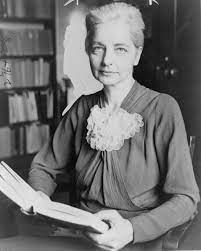Benedict, Ruth

Bio: (1887–1948) Ruth Benedict was an American anthropologist. She was educated at Vassar College. After that, she studied anthropology at the New School for Social Research in New York, where her professors were Alexander Goldenweiser and Elsie Clews Parsons. She got her Ph.D. at Columbia University, where she studied under, and was greatly influenced, by American anthropologist Franz Boas. Benedict started her academic carrier as an assistant professor to Boas (1931), later becoming acting executive director of the Department of Anthropology and professor at Columbia University. She was a founding member of the Institute for Intercultural Studies and was also the founder and editor for the life of the Journal of American Folklore.
Franz Boas and other diffusionists saw cultures as always changing and the diffusion of cultural patterns as the prime agent of that change. Even though Benedict was influenced in her early studies by diffusionism she realized that this approach doesn’t answer the question of “cultural integration.” Her answer to this question is presented in her integrative approach to culture, known by several names - “cultural relativism”, “theory of a ‘cultural configuration” and “culture and personality approach”. This approach viewed small-scale cultures holistically. To develop and test her theoretical approach she performed ethnographic research on North American native populations of Serrano, Zuni, Cochita, Pima, Pueblo, Dobu Islander, and Zuni. She researched personality types, interactive choices, and patterns of culture among those cultures.
Benedict presented her approach in the book Patterns of Culture (1934). Benedict explored the interdependent relationship between individuals and cultures. Cultures are shaped by choices made by individuals, and, in turn, cultures shape individual personality, thus we end up with a dynamic synergy of personality and cultural systems and culture-personality isomorphism. The humanistic cultural potential exists in all cultures, but individual creativity and individual choices play out differently in different cultures. Possibilities for the adoption or development of various cultural patterns in every culture are almost limitless, but through individual “selection” all those individual patterns are integrated into a consistent whole, a cultural totality. The meaning of any individual cultural pattern depends on its place within that whole, that is, on its relationship with all other patterns.
Benedict distinguishes two basic types of cultures by the way they shape individual personality. These two types are the Apollonian and Dionysian cultural models. These two models are borrowed from Nietzsche’s distinction between the Apollonian and the Dionysian in his book The Birth of Tragedy. Apollonian cultural model produced a personality characterized by calm, balanced, and nondestructive behavior, which was exemplified by the Pueblo people. In contrast, the Dionysian cultural model shaped personality with a penchant for excessive, violent, bellicose, and paranoid behavior, which was evident in the Pima, the Kwakiutl, and the Dobuan peoples.
During World War II the Army Information Bureau of the War Department commissioned Benedict to examine the national character of several countries: Germany, the Netherlands, Romania, Japan, and Thailand. This endeavor's product was a monograph on Japan's national character: The Chrysanthemum and the Sword (1946). In studying Japanese people most crucial task was to determine whether or not the US should remove the Japanese Emperor from the throne after the allied victory in the war. The most important values in Japanese society are concepts of hierarchy and indebtedness, which are in stark contrast to the most important American values of equality and freedom.
Japanese people see family and social relationships as grounded in indebtedness and hierarchy, and the greatest imperative for any Japanese individual is to fulfill their familial and social duties, as a form of repayment of debt to the supreme authority, whether in the family or the society. A sense of self-respect is tied to the execution of these duties and subjugation to authority. Because every culture is an integrated cohesive whole people from one culture tend to judge cultural patterns from other cultures, not by the standards of that other culture, but by standards of their own culture. This leads to cross-cultural misunderstandings. For example, Americans find Japanese culture to be without freedom, while Japanese people find American culture to be lawless. Benedict believed that anthropology would give people the tools to see their own, but also other cultures in a new way, so people can be more accepting of other cultures and change useless and inhumane customs in their own cultures.
.
Fields of research
Anthropology Authority Buddhism and Hinduism Character, Social Collectivism Community Conflict Conformity Control, Social Cooperation Culture Customs, Social Diffusion Discrimination Domination Family Freedom Geography Human Nature Identity Ideology Individualism Integration Monarchy Morality Motivation Patriarchy Personality Power, Political Prejudice Psychology Race Rationality Socialization Status Tradition Tribe Trust ViolenceTheoretical approaches
Culture and Personality ApproachMain works
Patterns of Culture (1934);
Zuni Mythology (1935);
Race: Science and Politics (1940);
The Chrysanthemum and the Sword: Patterns of Japanese Culture (1946).

